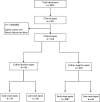Clinical and Bacteriological Profile of Neonatal Sepsis: A Prospective Hospital-Based Study
- PMID: 32952574
- PMCID: PMC7481930
- DOI: 10.1155/2020/1835945
Clinical and Bacteriological Profile of Neonatal Sepsis: A Prospective Hospital-Based Study
Abstract
Background: Neonatal sepsis remains one of the leading causes of mortality and morbidity in developing countries. With a dearth of data on neonatal sepsis in our country, this study was conducted to determine the incidence of clinical neonatal sepsis and evaluate the clinical, bacteriological, and antimicrobial susceptibility profile of organisms. Material and Methods. A prospective cross-sectional study was conducted in the Neonatal Unit of the National Hospital from 1st January to 31st December 2016. All neonates admitted with suspected clinical sepsis were included. Sepsis screens and cultures were sent under aseptic conditions. Data was analyzed using STATA™ version 12. Clinical features and neonatal and maternal risk factors were analyzed using chi-squared test. Bacteriological profile was analyzed with descriptive statistics.
Results: During the study period, incidence of culture positive neonatal sepsis was 19 per 1000 admissions with a blood culture positivity rate of 14%. 54.5% had culture-positive early-onset sepsis (EOS). Prematurity (p = 0.012), APGAR < 6 (p = 0.018), low birth weight (p < 0.001), and maternal intrapartum antibiotics (p = 0.031) significantly increased risk for culture-positive EOS. Prematurity (p < 0.001), low birth weight (p = 0.001), and parental nutrition (p = 0.007) were significantly associated with increased risk of culture-positive late-onset sepsis. A positive screen had sensitivity of 81.8% and negative predictive value of 87.7%. Gram-negative organisms were most commonly isolated (64.6%). Coagulase-negative Staphylococci (31%) were the commonest isolate followed by Klebsiella pneumoniae (27%) and Acinetobacter (18.8%). Ninety percent of Acinetobacter were carbapenem resistant. Gram-negative sepsis had mortality of 88.9%.
Conclusion: Preterm, low birth weight, low APGAR scores, intrapartum antibiotics, and parental nutrition were significantly associated with neonatal sepsis. Coagulase-negative Staphylococci, Klebsiella pneumoniae, and Acinetobacter were the principal causative organisms. Gram-negative organisms had high resistance to commonly used antibiotics.
Copyright © 2020 Jimba Jatsho et al.
Conflict of interest statement
The authors declare that they have no competing interests.
Figures
Similar articles
-
Bacteriological profile and antibiotic susceptibility of neonatal sepsis in neonatal intensive care unit of a tertiary hospital in Nepal.BMC Pediatr. 2018 Jun 27;18(1):208. doi: 10.1186/s12887-018-1176-x. BMC Pediatr. 2018. PMID: 29950162 Free PMC article.
-
Clinical and bacteriological profile of culture-negative and culture-proven neonatal sepsis in Palembang, Indonesia.J Infect Dev Ctries. 2022 Dec 31;16(12):1887-1896. doi: 10.3855/jidc.14638. J Infect Dev Ctries. 2022. PMID: 36753657
-
[An analysis of relative factors, bacteriological profile and antibiogram of neonatal sepsis].Zhonghua Yu Fang Yi Xue Za Zhi. 2018 Oct 6;52(10):1023-1028. doi: 10.3760/cma.j.issn.0253-9624.2018.10.011. Zhonghua Yu Fang Yi Xue Za Zhi. 2018. PMID: 30392321 Chinese.
-
Literature review on the distribution characteristics and antimicrobial resistance of bacterial pathogens in neonatal sepsis.J Matern Fetal Neonatal Med. 2022 Mar;35(5):861-870. doi: 10.1080/14767058.2020.1732342. Epub 2020 Feb 26. J Matern Fetal Neonatal Med. 2022. PMID: 32102584 Review.
-
Evidence review for antibiotics for treating late-onset neonatal infection: Neonatal infection: antibiotics for prevention and treatment: Evidence review H.London: National Institute for Health and Care Excellence (NICE); 2021 Apr. London: National Institute for Health and Care Excellence (NICE); 2021 Apr. PMID: 34133108 Free Books & Documents. Review.
Cited by
-
Early-Onset Neonatal Sepsis in Low- and Middle-Income Countries: Current Challenges and Future Opportunities.Infect Drug Resist. 2022 Mar 9;15:933-946. doi: 10.2147/IDR.S294156. eCollection 2022. Infect Drug Resist. 2022. PMID: 35299860 Free PMC article. Review.
-
Analysis of pathogens, drug resistance, sensitive antibiotic treatment and risk factors of early-onset sepsis in very low birth weight infants.Am J Transl Res. 2021 Nov 15;13(11):12939-12948. eCollection 2021. Am J Transl Res. 2021. PMID: 34956509 Free PMC article.
-
Incidence, pathogens and antimicrobial resistance of blood and cerebrospinal fluid isolates from a tertiary neonatal unit in South Africa: A 10 year retrospective review.PLoS One. 2024 Jan 19;19(1):e0297371. doi: 10.1371/journal.pone.0297371. eCollection 2024. PLoS One. 2024. PMID: 38241304 Free PMC article.
-
Factors associated with early onset neonatal sepsis among neonates in public hospitals of Sidama region, Southern Ethiopia, 2021: Unmatched case control study.Ann Med Surg (Lond). 2022 Sep 1;81:104559. doi: 10.1016/j.amsu.2022.104559. eCollection 2022 Sep. Ann Med Surg (Lond). 2022. PMID: 36147156 Free PMC article.
-
Characterization of Clinical Presentation, Etiology, and Antibiotic Sensitivity Patterns in Neonatal Septicemia: A Comprehensive Analysis of Bacterial Isolates.Cureus. 2024 Jun 26;16(6):e63259. doi: 10.7759/cureus.63259. eCollection 2024 Jun. Cureus. 2024. PMID: 39070484 Free PMC article.
References
-
- Stoll B. J. S. A. Nelson Textbook of Pediatrics. 20th. Philadelphia: Elsevier; 2015. Infections of the neonatal infant; pp. 909–925.
LinkOut - more resources
Full Text Sources


